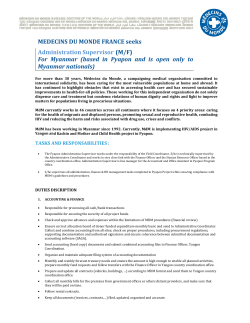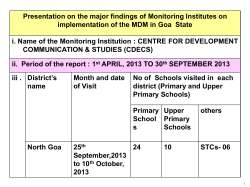
MDM Technology: How to Create the Perfect Solution Sponsored by:
MDM Technology: How to Create the Perfect Solution Sponsored by: Copyright ©2014 CBS Interactive Inc. All rights reserved. MDM Technology: How to Create the Perfect Solution Contents Introduction ................................................................................................................. 3 Unavoidable: 62 percent of companies to allow BYOD by year’s end ........................... 4 Four stages to conquer mobile content management .................................................. 7 Research: 41 percent increasing IT security budget in 2014 ...................................... 10 PwC: Software at the forefront of tech M&A activity in 2014 ...................................... 13 7 things to think about with enterprise mobile service architecture ............................. 14 Five Takeaways ......................................................................................................... 16 About Skyhook and ZDNet......................................................................................... 17 This document is comprised of CBS Interactive editorial material and has been written and compiled by CBSi editors and affiliates. While Skyhook may have had input on the topic and title of the guide and is the exclusive sponsor, CBSi has maintained editorial control of the content in this guide. Copyright ©2014 CBS Interactive Inc. All rights reserved. 2 MDM Technology: How to Create the Perfect Solution Introduction By the end of 2014, 62% of organizations will institute Bring Your Own Device policies. This means a constantly mobile, constantly connected workforce will be armed with crucial business data at all times. The ability to manage and protect the devices carrying this data will be a critical aspect of any IT department’s operations. Fortunately, there are technology companies that are simplifying and securing the management of mobile devices. Mobile Device Management (MDM) services and technology providers must understand the needs, risks and day-today processes of the organizations they serve. They must Mobile Device Management understand how and why devices are being used in order to (MDM) services and technology provide seamless and secure technology. This can be a tricky providers must understand the process, especially as mobile needs change industry-wide, and as the mobile workforce increases in size. If your organization is looking for more information on building out your MDM technology, this Tech Roundup is the perfect needs, risks and day-to-day processes of the organizations they serve. resource for you. Packed with articles from pre-eminent editors and bloggers on the leading IT media outlets, TechRepublic and ZDNet, this editorial reference guide provides you with objective information on MDM technology done right. In addition to leading editorial, we’ll offer you several key takeaways to consider as you improve your solution. u 3 Copyright ©2014 CBS Interactive Inc. All rights reserved. MDM Technology: How to Create the Perfect Solution Unavoidable: 62 percent of companies to allow BYOD by year’s end By Teena Hammond As employees bring their personal smartphones, tablets and laptops to the office, or use them offsite as they take their work home, IT departments are grappling with the growing Bring Your Own Device (BYOD) trend. More than 44 percent of This change in how people work and the devices organizations already allow setting BYOD guidelines to protect company security as they’re working on is leading to many IT departments BYOD and another 18 percent employees access email and other potentially proprietary plan to move to BYOD by the to data is controlled and productivity can be extended to end of 2013. data on their own devices. By setting guidelines, access these devices. Get a head start on launching a BYOD program with TechRepublic’s ready-made BYOD policy. To better understand how IT departments are approaching BYOD, we invited TechRepublic and ZDNet members to take a BYOD Business Strategy Survey. A wide array of responses was received with more than 1,000 people worldwide participating. The following are just two surprising facts we discovered: More than 44 percent of organizations already allow BYOD and another 18 percent plan to move to BYOD by the end of 2013. 4 Copyright ©2014 CBS Interactive Inc. All rights reserved. MDM Technology: How to Create the Perfect Solution BYOD isn’t new for those who allow it, with 61 percent of companies with policies already in place having those policies for more than a year. 5 Copyright ©2014 CBS Interactive Inc. All rights reserved. MDM Technology: How to Create the Perfect Solution Respondents also revealed their reasons for not adopting a BYOD policy. Security topped the list, but there were other, less obvious, motives. For companies with policies in place, our research uncovered the following: • Brand/Type of device most often issued by the company • Device brand restrictions • Percentage of employees who participate in the program • Type of personal devices used most often for work • Security approaches • Hardware/Service plan costs (i.e. who’s paying) Whatever position your company takes on BYOD, whether to allow it or not, the information in this report can help you develop a BYOD plan that serves both the organization and employees. u 6 Copyright ©2014 CBS Interactive Inc. All rights reserved. MDM Technology: How to Create the Perfect Solution Four stages to conquer mobile content management By Teena Hammond Mobile content management (MCM) is becoming more important as a platform for enterprises as mobility and Bring Your Own Device (BYOD) provide the technology framework for today’s workforce. Naturally, this means that the market is quickly flooding with MCM solutions from mainstream collaboration tools vendors and mobile app developers. Even the mobile device management (MDM) players are getting into the act. I must also note that my recent research into MCM also shows it is converging with mobile collaboration in both product roadmaps and how enterprise mobile users are interacting with corporate content from their mobile devices. I put my analysis of MCM in front of Yaacov Cohen, CEO of harmon.ie, a collaboration tools provider focusing on Office 365. Stage 1: Rogue IT or Shadow IT - Free cloud storage phase The first stage of mobile content management considered by some on the market as Rogue IT (otherwise known as ShadowIT). This is where mobile users with a little bit of knowledge begin putting corporate documents into personal cloud storage accounts on Dropbox, Google Drive, Box, or OneDrive (formerly SkyDrive). Two reports that can speak more to risks of the Rogue IT stage are: • The High Cost of Mobile Business Users’ Rogue IT Practices (PDF) from harmon.ie • State of the Enterprise Information Landscape (PDF) from Huddle, a collaboration platform that challenges SharePoint While consumer cloud vendors including Dropbox and Box have released two-factor authentication, it doesn’t mean users are going to implement security measures especially if they are using free storage without the blessing of corporate management The security risks inherent with stage 1 mean enterprises don’t want to stay here long. Likewise, the requisite endpoint security needs to be in place or else elements of stage 1 could remain in place. 7 Copyright ©2014 CBS Interactive Inc. All rights reserved. MDM Technology: How to Create the Perfect Solution Stage 2: Cloud solutions, mobile device management and intelligent mobile apps With Office 365, Huddle, and RedHost taking collaboration to the cloud, stage 2 means that an enterprise can approach MCM in a Today’s cloud more mature manner with user privileges, true file locking, content collaboration platforms version control, and intelligent mobile apps from innovative mean their own class of platform and third party vendors. Stage 2 is more about control and collaboration, less about the ad hoc convenient file storage intelligent mobile apps. that marks stage 1. Today’s cloud collaboration platforms mean their own class of intelligent mobile apps. I’ve written about harmon.ie’s SharePoint client offerings on both iOS and Android. Colligo is also doing some excellent work with Colligo Briefcase. Huddle’s mobile app includes a patent pending document recommendation engine and improvements on the mobile app are certain to play into Huddle’s overall product roadmap. Traditional MDM vendors including MobileIron, AirWatch, and Good have their own app stores now. Vendors including harmon.ie have released secure versions of their apps that integrate directly with the MDM solution. As MCM gains more intelligence in stage 2, Mobile Identity Management becomes an option as distinct requirements for device security and cloud access grow for enterprises. Tom Kemp, CEO of Centrify, a leading identity tools vendor that support mobile and cloud application said, “First and foremost, ensure the device is secure. Second, you want mobile application management to deploy the app to the device, then the next thing is what people really want is that people don’t want to always have to enter their username and password when they access files.” Stage 3: Cloud, MDM, intelligent mobile apps, and social The introduction of an enterprise social component to MCM marks stage 3. “I would say if you are serious about collaboration – your second stage – you need social,” adds Cohen. He labels it a natural evolution because it takes mobile users beyond the document and fosters brainstorming You can have social interactions, and say ‘hey, why don’t you update this slide.” You can already look at that as the third one. The social component that arrives with stage 3 is especially important as companies turn to mobile first strategies, geographically dispersed workforces, and contractors to serve their customers. 8 Copyright ©2014 CBS Interactive Inc. All rights reserved. MDM Technology: How to Create the Perfect Solution Stage 4: Emergence of context and location-based technologies in MCM “Context or intelligence is the next generation,” says Cohen. “Nobody is really doing it.” His look into the future of context is the content being brought to the mobile user when they need it. His example to me was an employee has an important meeting with a manager or executive. A mobile content management solution pushes the latest documents you have rights to on the collaboration platform and even recent enterprise social posts from the meeting attendees. He also predicts that the REST API will play a role in the future phase and query Salesforce and perhaps other backend systems for data pertinent to the meeting. This data would in turn appear on the mobile devices of authorized meeting attendees. “Context or intelligence is the It could even be location-based. Cohen points to where a next generation,” says Cohen. information “Nobody is really doing it.” mobile device’s location can help drive further contextual Stage 4 wasn’t in my original article. It’s Cohen’s suggestion to me and matches other activity I’m seeing in the market, so I added it to my original three stages. For example, I recently got a briefing from Blake Brannon, global sales engineering manager for Air Watch about recent updates to the Air Watch Content Locker. Geographic-base security called Geo-fencing is part of the product enabling enterprises to lock down corporate content by geographic location. Other vendors are moving in a similar direction. Look for an upcoming TechRepublic post from me about the AirWatch Content Locker. Final thoughts Through changing business rules, technology, or security concerns, the state of mobile content management is continuously evolving. Enterprises need to manage their mobile content management requirements from inception through the next generation technology options that stage 4 offers a mobile workforce. u 9 Copyright ©2014 CBS Interactive Inc. All rights reserved. MDM Technology: How to Create the Perfect Solution Research: 41 percent increasing IT security budget in 2014 By Teena Hammond Security is always a concern for IT professionals, and media news reports of breaches and leaks, combined with internal threats, have further increased worries. A recent Tech Pro Research survey focused on IT security. The survey attracted 244 respondents from around the globe and from organizations of all sizes. The resulting report, IT Security: Concerns, budgets, trends and plans, focuses on the key findings from the survey. Budgets were a hot subject. Overall, 41 percent of survey respondents said they will increase their IT security budget next year. This is a 16 percent increase compared to the number of budgets that rose in 2013. In addition, only 11 percent of all respondents said they plan to decrease their security budget next year. About two-thirds of the respondents said they are now more concerned with security, following media reports of breaches and 41 percent of survey leaks. However, only large organizations with more than 1,000 respondents said they will employees are planning to improve IT security controls. Smaller increase their IT security companies are lagging behind in the implementation of IT security budget next year. controls. Security projects were also discussed, with the top project for 2014 remaining the same as 2013: the development of better risk management processes. 10 Copyright ©2014 CBS Interactive Inc. All rights reserved. MDM Technology: How to Create the Perfect Solution One of the top security concerns for businesses in 2014 will be Bring Your Own Device (BYOD). Lack of employee awareness regarding social engineering attacks was the number-one concern in 2013, but this moved to joint second place for 2014, with BYOD taking the top slot. BYOD has been such an ongoing topic that Tech Pro Research has created a ready-made BYOD policy that companies can download to use as their own policy. 11 Copyright ©2014 CBS Interactive Inc. All rights reserved. MDM Technology: How to Create the Perfect Solution The report also addresses the following IT security topics: • Employee awareness challenges • Improved risk management leads • Managing internal threats • Moving to risk management • BYOD challenges u 12 Copyright ©2014 CBS Interactive Inc. All rights reserved. MDM Technology: How to Create the Perfect Solution PwC: Software at the forefront of tech M&A activity in 2014 By Rachel King This might seem rather obvious following Facebook’s astounding and ginormous acquisition of WhatsApp on Wednesday, but mergers and acquisitions in the tech world are poised to stay strong this year. That’s the major takeaway from the latest recap and forecast from PricewaterhouseCoopers, which published both its US Technology Deals Insights 2013 Year in Review and 2014 Outlook reports on Thursday. Following some missteps and disappointments in 2011 and 2012, analysts from the global consulting firm repeatedly predicted better things throughout 2013 as far as both tech M&A and IPO activity were concerned. PwC was right for the most part, although the Deal Insights report noted that the cumulative technology deal value for 2013 closed at $99.8 billion, down three percent from 2012. Nevertheless, PwC pointed toward “an abundance of cash reserves from technology majors and record levels of private equity capital” at the end of the year, which they believe have set the stage for an uptick in technology deals this coming year. But where the money is going might still come as a bit of a surprise -- at least to those only paying attention to flashy trends and big-number predictions. (See: Varying forecasts for the number of connected devices expected to take over the world between 2017 and 2020.) Rather than mobile and big data, which are arguably the buzzwords du jour in enterprise technology, plain old software is still the ringleader as analysts argue that this sector will remain at the forefront of tech deals. That’s because software, as it expands into the cloud to be delivered as a service, helps fuel and power these other verticals. PwC cited that software accounted for 35 percent of technology M&A volume in 2013. That pace should continue, but expect some alterations. PwC cited that software For one, analysts proposed that the “lines between the accounted for 35 percent of means combined sub-sector deals will likely decline. technology M&A volume in 2013. Software and Internet sectors continue to fade,” which However, software is getting a boost as hardware M&A activity looks mixed. To fill in the gaps (such as infusing intelligence and automation into more critical processes), PwC concluded that there will be “more software acquisitions that enable users to orchestrate traditional hardware tasks with software.” u 13 Copyright ©2014 CBS Interactive Inc. All rights reserved. MDM Technology: How to Create the Perfect Solution 7 things to think about with enterprise mobile service architecture By Joe McKendrick In a recent article posted in Service Technology, Drs. Longji Tang of Hunan University, and Wei-Tek Tsai of Arizona State University propose “Enterprise Mobile Service Architecture (EMSA),” which they describe as a new enterprise architectural approach for mobile system integration. “EMSA is a hybrid architectural style composed of enterprise mobile computing, enterprise SOA, as well as enterprise cloud service architecture,” Tang and Tsai state. The greatest distinction from a traditional architecture supporting PC-based clients is that the success of mobile depends on the vendors providing the backbone services. Here are the seven key “views” that comprise a well-functioning EMSA: Enterprise Mobile Service: This comes from the provider side. The manufacturers of mobile devices often provide built-in services, such as native SMS service, email service, mobile web services, and cloud services, the authors point out. Enterprise Mobile Service Consumer: This is the application, not the user. Enterprise mobile service consumer can be defined as any mobile application or user interface that is provisioned in the mobile devices, and that can access and consume enterprise mobile services. Enterprise Mobile Service Data and Mobile Context: Mobile computing is different from traditional distributed computing in that data and the context of data is constantly changing, versus working from a stationary PC. “The ‘mobile context’ is a dynamic data set,” influenced by users’ tendency to roam, thereby quickly passing from one environment to another. “Context-awareness is defined as a service capacity with full awareness of current service execution environment that includes location, time, and user information.” Enterprise Mobile Service Process: The role of the device in completing business processes. The EMSP is an extension of the general enterprise service process (ESP), “a set of composed and managed services for completing a complex business process, such as online shopping or shipping workflow, or any business transaction process.” Enterprise Mobile Service Infrastructure: The EMSI is an extension of SOA infrastructure. Tang and Tsai state. However, the performance and reliability of mobile clients are dependent on the backbones of mobile network providers. 14 Copyright ©2014 CBS Interactive Inc. All rights reserved. MDM Technology: How to Create the Perfect Solution Enterprise Mobile Service Management: While following general SOA management principles, EMSM also addresses specific aspects and principles “based on mobile constraints, specifically on mobility, real-time, and highly dynamic behaviors.” Such constraints include the fragmentation seen across the mobile space in terms of form factors, operating systems and browsers -- as well as the routing of Web content through operator networks. Enterprise Mobile Service Quality Attributes: These track closely to enterprise SOA quality attributes, including performance, reliability, scalability, reusability, maintainability, security, cost, and interoperability. u 15 Copyright ©2014 CBS Interactive Inc. All rights reserved. MDM Technology: How to Create the Perfect Solution FIVE TAKEAWAYS Five points you should take away from this reference guide: 1. Be Excited: BYOD is quickly becoming the norm. Your services will be needed more in the coming year than they were in previous years. Get your team up-to-speed and be prepared to deliver your services to more organizations, to more employees, on many more devices. 2. Be Safe: Organizations are more cognizant of security concerns than they’ve ever been. When they come to you for your expertise, they’re going to want you to lead them toward a more secure mobile ecosystem. Do what it takes to guarantee their data doesn’t end up in the wrong hands. 3. Be Diverse: Your clients will view their mobile architecture through many different lenses, from the applications they run, to the data they’re able to collect, to the infrastructure the systems are built on. It’s your job to ensure that all of these variables interconnect seamlessly. Do what it takes to provide one cohesive management solution. 4. Be Nimble: Over the past five years, we’ve seen how much the mobile landscape has changed. In the next five years, mobile adoption and functionality will look radically different than it does today. You must stay ahead of these trends and guarantee the same level of MDM expertise regardless of where the technology takes the industry. 5. Be Innovative: The organizations that dictate the pace and adoption of new MDM technologies will be the first stop for businesses looking to advance their mobile strategies. Make sure that you’re striving to achieve new advancements, rather than simply catching up to current technology. You may stumble along the way, but your successes will overshadow your failures. u 16 Copyright ©2014 CBS Interactive Inc. All rights reserved. MDM Technology: How to Create the Perfect Solution About ZDNet ZDNet (www.zdnet.com) is where technology means business. The site attracts an enthusiastic and interactive audience of business technology influencers, many of whom visit for the latest coverage and analysis of how technology impacts business. Business leaders and decision makers including CEOs, CIOs and IT professionals at all levels value the site due to its extensive resources, enabling them to make the most out of technology for their business challenges. About Skyhook Skyhook is the big data company that is continuously reinventing location. With more than a billion geo-located Wi-Fi access points, 7 billion+ monthly location requests, 10s of millions of devices, 2.5 million geofencable points of interest, 1 billion+ geolocated IP addresses and 30 million+ cell towers, Skyhook technology enables businesses to gain unprecedented levels of insight to optimize mobile experiences, provide the right content when it’s needed and certify that someone is where they say they are. For MDM providers, Skyhook’s SDK ports easily to any operating system or platform on all smartphones, tablets, and laptops, allowing for better UX, new revenue models and improved app integration. Learn more about how Skyhook serves MDM and MAM providers. 17 Copyright ©2014 CBS Interactive Inc. All rights reserved.
© Copyright 2025





















